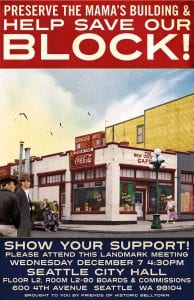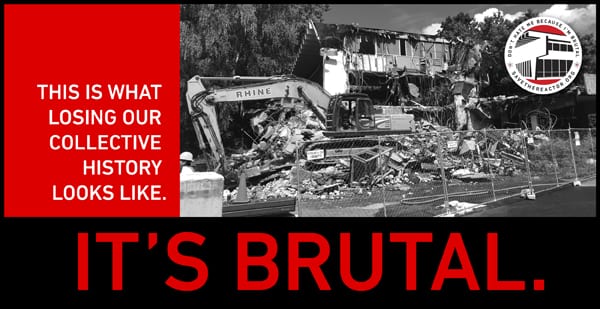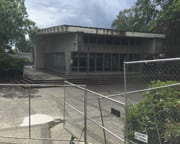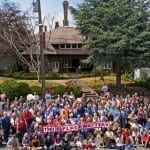Mama’s Mexican Restaurant Building Nominated
 On Wednesday, December 7, 2016, the Seattle Landmarks Preservation Board voted unanimously to nominate the iconic Mama’s Mexican Kitchen building at 2234 Second Avenue (in Belltown) as a Seattle Landmark. The nomination was submitted by the property owner/developer, who has plans to redevelop the property. Preservation advocates call these types of nominations “anti-nominations,” in which the owner tries to make the case that the property does not meet the designation standards of the Landmarks Preservation Ordinance, and/or does not possess integrity or the ability to convey significance.
On Wednesday, December 7, 2016, the Seattle Landmarks Preservation Board voted unanimously to nominate the iconic Mama’s Mexican Kitchen building at 2234 Second Avenue (in Belltown) as a Seattle Landmark. The nomination was submitted by the property owner/developer, who has plans to redevelop the property. Preservation advocates call these types of nominations “anti-nominations,” in which the owner tries to make the case that the property does not meet the designation standards of the Landmarks Preservation Ordinance, and/or does not possess integrity or the ability to convey significance.
The developer’s attorney, Jack McCullough, started out by arguing that it was a “run-of-the-mill” structure that didn’t deserve to be protected. David Peterson from NK Architects, who prepared the landmark nomination, highlighted the building’s supposedly poor condition and physical alterations – including the 1950s aluminum storefront on the center bay, signage over the transom windows, and other infill along the north facade – that compromised the overall integrity. Referencing the neighborhood historic context statement, he stated that the Mama’s building was a “simple, utilitarian” structure and not significant enough to meet Standard D of the Landmarks Preservation Ordinance, (a property “embodies the distinctive visible characteristics of an architectural style, or period, or a method of construction.”)
Historic Seattle joined representatives from various community groups – including Friends of Historic Belltown, Belltown Community Council, and Project Belltown – to offer public comments in support of the nomination. Friends of Historic Belltown noted that “Belltown doesn’t have many fancy buildings, but rather that the community’s history is with working buildings for ‘the common man,’ and that the Mama’s building embodied that history.”
David Levinson, a Belltown Community Council member and longtime resident, described how the restaurant served as a community gathering place for decades, including Belltown’s labor union members who met there regularly.
The Board demonstrated support for moving the nomination forward to the designation phase, noting that the building may meet several standards and still remains largely intact. Deb Barker said that the portions that haven’t been altered (NE and E alley façades) make it “crystal clear” what the building was. Julianne Patterson stated that the alley facade has “almost perfect integrity,” and she mentioned the idea of “intangible heritage” and how the building is tied to its association with Mama’s Restaurant, even though the restaurant is no longer there.
Friends of Historic Belltown say they “feel a bit bad for the developers, who had been working with the community to design a proposed development that fit in with the neighborhood,” adding that they did not take into consideration the building’s historic value before purchasing the property. “It’s like buying property with a wetland and eagle’s nest on it — you can’t simply bulldoze it just because you didn’t know those features have public values that are protected by law.”
A designation hearing for the Mama’s building will be scheduled in January or February 2017. Friends of Historic Belltown are “elated that the Board saw things the same way we do” and are “looking forward to the next round — the Mama’s Superbowl – to establish our second Landmarked building on ‘the block.’” The Wayne Apartments, built in 1890 and located adjacent (south) of Mama’s, was recently designated a Seattle landmark.
Images: Seattle Landmarks Preservation Board votes to nominate the Mama’s Mexican Kitchen Building, photo: Steve Hall; “Preserve the Mama’s Building” poster, Friends of Historic Belltown

 Preservation advocates around the state were alerted. Docomomo WEWA, Historic Seattle, and the Washington Trust for Historic Preservation teamed up to support the efforts of the students. You were even listed on the Trust’s Most Endangered Properties list in 2008. That same student successfully got you listed on the Washington Heritage Register in 2008 and on the National Register of Historic Places in 2009. The UW objected to the listing of course. You made the press—local and national media covered your story and plight to be appreciated and used again. You welcomed adaptive reuse with open arms. And you believed there was room for a new building if it was sited and designed well. But you continued to be ignored by the very same entity that created you. You became a polarizing figure. Like some of your Brutalist siblings you were called “ugly” and “cold.” Some called for your destruction saying you were “getting in the way of progress.” Social media has made it too easy to hide behind anonymous comments. But you persevered. The vitriol directed at you was hurtful but you had thick concrete skin. These insults emboldened you and your supporters.
Preservation advocates around the state were alerted. Docomomo WEWA, Historic Seattle, and the Washington Trust for Historic Preservation teamed up to support the efforts of the students. You were even listed on the Trust’s Most Endangered Properties list in 2008. That same student successfully got you listed on the Washington Heritage Register in 2008 and on the National Register of Historic Places in 2009. The UW objected to the listing of course. You made the press—local and national media covered your story and plight to be appreciated and used again. You welcomed adaptive reuse with open arms. And you believed there was room for a new building if it was sited and designed well. But you continued to be ignored by the very same entity that created you. You became a polarizing figure. Like some of your Brutalist siblings you were called “ugly” and “cold.” Some called for your destruction saying you were “getting in the way of progress.” Social media has made it too easy to hide behind anonymous comments. But you persevered. The vitriol directed at you was hurtful but you had thick concrete skin. These insults emboldened you and your supporters.
 The preservation of the Alki Homestead in West Seattle has been a sustained advocacy effort for Historic Seattle since 2009. Originally known as the Fir Lodge, the Homestead is one of West Seattle’s most beloved landmarks. The 1904 log building has been vacant for over six years, after a 2009 fire caused significant damage and forced the closure of the Alki Homestead Restaurant.
The preservation of the Alki Homestead in West Seattle has been a sustained advocacy effort for Historic Seattle since 2009. Originally known as the Fir Lodge, the Homestead is one of West Seattle’s most beloved landmarks. The 1904 log building has been vacant for over six years, after a 2009 fire caused significant damage and forced the closure of the Alki Homestead Restaurant.
